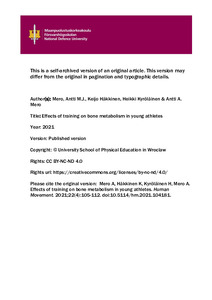Effects of training on bone metabolism in young athletes
Mero, Antti M.J.; Häkkinen, Keijo; Kyröläinen, Heikki; Mero, Antti A. (2021)
Mero, Antti M.J.
Häkkinen, Keijo
Kyröläinen, Heikki
Mero, Antti A.
Wroclaw University of Health and Sport Sciences
2021
Julkaisun pysyvä osoite on
https://urn.fi/URN:NBN:fi-fe2023030930990
https://urn.fi/URN:NBN:fi-fe2023030930990
Tiivistelmä
Purpose.
This study investigated the effects of two types of training on the bone formation marker of osteocalcin and the bone resorption marker of tartrate-resistant acid phosphatase isoenzyme 5b (TR AP5b) in young track and field boys and girls.
Methods.
The 14-year-old group (10 boys, 10 girls) performed first time an intensive and supervised 8-week plyometric training. In the 17-year-old group (13 athletic boys, 6 control boys, 12 athletic girls, 6 control girls), the normal many-sided track and field training lasted 6 months.
Results.
Significant increases were noticed in osteocalcin (p < 0.01) both in younger boys and girls. The 20-m sprint performance improved in girls (p < 0.01) and the countermovement jump height increased in boys (p < 0.001). Significant increases in 17-year-old boys and girls were observed after training in osteocalcin (p < 0.01), osteocalcin/TR AP5b ratio (p < 0.01 and p < 0.001), and the standing 5-jump (p < 0.05 and p < 0.01). Serum TR AP5b decreased both in boys (p < 0.05) and in girls (p < 0.01). The boys also improved the standing 5-jump (p < 0.01) and the 12-minute running test results (p < 0.05). In the combined group of all subjects, the correlation coefficient between TR AP5b and age was significant (r = –0.63, p < 0.001, n = 57).
Conclusions.
In practice, it is important to add plyometrics and other strength training in the training plans of young athletes, regardless of their events, to increase their bone metabolism and muscle strength.
Key words: anabolism, exercise, children, puberty
This study investigated the effects of two types of training on the bone formation marker of osteocalcin and the bone resorption marker of tartrate-resistant acid phosphatase isoenzyme 5b (TR AP5b) in young track and field boys and girls.
Methods.
The 14-year-old group (10 boys, 10 girls) performed first time an intensive and supervised 8-week plyometric training. In the 17-year-old group (13 athletic boys, 6 control boys, 12 athletic girls, 6 control girls), the normal many-sided track and field training lasted 6 months.
Results.
Significant increases were noticed in osteocalcin (p < 0.01) both in younger boys and girls. The 20-m sprint performance improved in girls (p < 0.01) and the countermovement jump height increased in boys (p < 0.001). Significant increases in 17-year-old boys and girls were observed after training in osteocalcin (p < 0.01), osteocalcin/TR AP5b ratio (p < 0.01 and p < 0.001), and the standing 5-jump (p < 0.05 and p < 0.01). Serum TR AP5b decreased both in boys (p < 0.05) and in girls (p < 0.01). The boys also improved the standing 5-jump (p < 0.01) and the 12-minute running test results (p < 0.05). In the combined group of all subjects, the correlation coefficient between TR AP5b and age was significant (r = –0.63, p < 0.001, n = 57).
Conclusions.
In practice, it is important to add plyometrics and other strength training in the training plans of young athletes, regardless of their events, to increase their bone metabolism and muscle strength.
Key words: anabolism, exercise, children, puberty
Kokoelmat
- Artikkelit [104]
